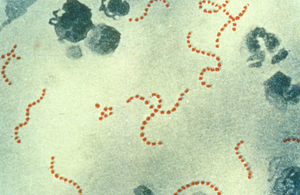Scarlet fever cases increase across England
Scarlet fever has significantly increased across England, with a total of 3,548 new cases since September 2013.

Public Health England (PHE) has reported significant increases in scarlet fever notifications across England, with a total of 3,548 new cases since the season began in September 2013, compared to an average of 1,420 cases reported for the same period in the previous 10 years. The last season to have this level of scarlet fever activity was 1989 to 1990 when 4,042 notifications were received.
Scarlet fever is an infectious disease caused by group A streptococcus bacterium. Typically there are seasonal rises in scarlet fever between December and April each year, and also a cycle of increases and decreases in incidence that repeats over a period of several years. This most recent increase is likely to be part of that cycle.
Routine monitoring of surveillance data identified widespread increases in scarlet fever notifications in February 2014 compared to recent years. These increases continued into March, with weeks 10 and 11 of 2014 being particularly high with numbers of notifications surpassing levels seen in the last peak year of 2008 and 2009. As a result of this increase in scarlet fever, PHE is alerting health practitioners so they can be mindful of the current increase when assessing patients.
Dr Theresa Lamagni, PHE’s head of streptococcal infection surveillance, said:
The first symptoms of scarlet fever often include a sore throat, headache, fever, nausea, and vomiting. Between 12 to 48 hours after this, a characteristic rash develops. Cases are more common in children although adults can also develop scarlet fever. Symptoms usually clear up after a week and the majority of cases can be treated with a course of antibiotics to reduce risk of complications.
PHE recommends that people with symptoms of scarlet fever see their GP. Once children or adults are diagnosed with scarlet fever we strongly advise them to stay at home until at least 24 hours after the start of antibiotic treatment to avoid passing on the infection.
PHE publishes guidance for schools where infections can spread easily. Where outbreaks occur, local health protection teams are on hand to provide a rapid response, effective outbreak management and authoritative advice.
Scarlet fever is mainly a childhood disease and is most common between the ages of 2 and 8 years. It was once a very dangerous infection, but has now become much less serious. Antibiotic treatment should be given to minimise the risk of complications. There is currently no vaccine for scarlet fever.
PHE continue to monitor these increases and are working closely with healthcare professionals to try and halt the spread of infection.
Notes to editors
-
Public Health England’s mission is to protect and improve the nation’s health and to address inequalities through working with national and local government, the NHS, industry and the voluntary and community sector. PHE is an operationally autonomous executive agency of the Department of Health. www.gov.uk/phe Follow us on Twitter @PHE_uk
UKHSA press office: National Infection Service
UKHSA press office, infectious diseases
61 Colindale Avenue
London
NW9 5EQ